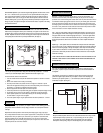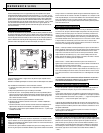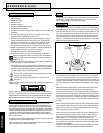
BUT FIRST: TYPES OF CONNECTORS
Bare wire — Pull the two conductors apart for about an inch and strip approximately
1/4”
of
insulation from the end of each. (A wire stripper will simplify this, but you can use an ordinary
pocket knife to cut around and through the insulation down to the wire.) Twist the strands of wire on
each individual conductor tightly together. Loosen the nuts on a pair of binding posts until the holes
through the metal posts are exposed, then insert the bare wire through the holes. Screw the nuts
down finger-tight on the wire. Make sure that no strands of wire are touching from one binding post
to the other or to any strands from the other conductor. Failure to observe this precaution at either
end of the connection can result in amplifier malfunction or damage.
Pins — Many pre-made speaker cables are terminated with metal pins. Loosen the nuts on a
pair of binding posts until the holes through the metal posts are exposed, then insert the pins
through the holes. Screw the nuts down finger-tight on the pins — do not over-tighten. Make
sure that there is no metal-to-metal contact between the two pins or binding posts. Failure to
observe this precaution at either end of the connection can result in amplifier malfunction or
damage.
Spade lugs — Some speaker cables are terminated with U-shaped connectors called spade
lugs. Loosen the nuts on a pair of binding posts and slip the spade lugs around the metal posts.
Screw the nuts down finger-tight on the lugs and inspect to ensure they have remained firmly
in place. Make sure that there is no metal-to-metal contact between the two lugs or binding
posts. Failure to observe this precaution at either end of the connection can result in amplifier
malfunction or damage.
OTHER TYPES OF SPECIALTY CONNECTORS ARE AVAILABLE TO FACILITATE HOOKING UP YOUR
SPEAKERS. PLEASE CONSULT YOUR AUTHORIZED KLIPSCH DEALER FOR SUGGESTIONS AND
FURTHER DETAILS.
SPEAKERS TO AMPLIFIER: KEEPING IT STRAIGHT
One of the most important things about hooking up your speakers is keeping them in the
same polarity, or phase. If they are connected out of phase, bass and sound localization will
be degraded.
The easiest way to ensure that your speakers are wired in phase is to always connect the
positive and negative output terminals on your amplifier or receiver to the matching input
terminals on your speakers: positive ("+", color-coded red) to positive and negative ("–", color-
coded black) to negative. (See Figure 3).
Most pre-termina
ted speaker ca
bles ha
ve color-coded connectors that make it easy to match
output and inputs correctly. If yours do not, or if you are making your own out of paired,
two-conductor wire,
look f
or identifying marks on the insula
tion of the two conductors.
Normall
y there will be printing,
a stripe or a molded ridge along one of the conductors.
Surround Back Speakers: If your electronics support Dolby Digital EX, THX Surround EX, or DTS-
ES 7.1 or 6.1-channel surround, you can place one or two speakers behind the seating area to
serve as surround back speakers. As with the left and right surrounds, the optimum location is
above seated ear level. If you are using just one back surround speaker, it should be centered
behind the listening area; if you are using two, they should be spaced fairly close together. With
this type of system, the regular left and right surrounds should be located adjacent to the seating
area rather than behind it.
STAND ADJUSTMENT AND WALL MOUNTING
The RVX-42’s attach to their stands via a bolt that allows them to be used in either the vertical ori-
entation as they are shipped for shelf top use or horizontally, as is typical for center channel use.
To adjust the base, remove the stand bolt tool from the rear of the unit and remove the bolt from
the stand. Reposition the stand in the center mounting point and then replace the stand bolt tool
in the opening that the stand bolt was previously installed within. (See Figure 2).
You may also use an optional wall or ceiling mount that will fit the provided 3/8" – 16 inserts.
Please see your authorized Klipsch dealer to determine which model is right for you.
To install the RVX-42, follow the instructions below:
Locate the included wall mount template with bubble level and position on the wall in the desired
location.
Mark the screw loca
tions for the model you are installing.
Screw #8 pan head wood screws (a
t least two inches in length) into a wood stud or dr
y wall
anchors with the appropriate load rating. Leave the screw heads protruding from the wall surface
approximately 1/4” and adjust as needed when hanging the speaker.
Attach the supplied self-stick rubber pads to the rear of the speaker.
Connect the speaker wire to the speakers binding posts. See “Speaker to Amplifier: Keeping it
Flip the switch at the top of the rear of the speaker to “On Wall” for accurate bass response.
Hook the speaker keyholes on the screw heads protruding from the wall. Adjust the height of
the screw heads for a snug fit. Do not over-tighten.
Fine tune the speaker’
s angle if using an optional wall mount tha
t fits the provided 3/8" – 16 inserts.
CONNECTIONS
Note: Proper connection of your speakers to your amplifier or receiver is vital to obtaining good sound
quality. Please follow these directions carefully. Sloppy connections can cause amplifier malfunction
or damage.
Klipsch Reference Series speakers are wired internally with multiple gauges of high-purity copper
wire, carefully selected and wound to ensure optimum signal transfer at all frequencies. You will obtain
best perf
ormance from your speakers if you connect them to your amplifier or receiver with similar
quality wire available from your dealer. We recommend that you use 18-gauge or heavier (lower-
gauge) stranded copper wire. Use a lower gauge (heavier) wire for longer runs to reduce the amount
of amplifier power lost due to the wire’
s resistance.
Figure 2
Figure 3
1.
2.
3.
4.
5.
6.
7.
8.
ENGLISH
straight


















